Files in this item
Chronic exposure to imidacloprid increases neuronal vulnerability to mitochondrial dysfunction in the bumblebee (Bombus terrestris)
Item metadata
| dc.contributor.author | Moffat, C. | |
| dc.contributor.author | Goncalves Pacheco, J. | |
| dc.contributor.author | Sharpe, S. | |
| dc.contributor.author | Samson, A.J. | |
| dc.contributor.author | Bollan, K.A. | |
| dc.contributor.author | Huang, J. | |
| dc.contributor.author | Buckland, Stephen Terrence | |
| dc.contributor.author | Connolly, C.N. | |
| dc.date.accessioned | 2015-07-15T08:40:05Z | |
| dc.date.available | 2015-07-15T08:40:05Z | |
| dc.date.issued | 2015-05 | |
| dc.identifier | 202250183 | |
| dc.identifier | c167404a-4d58-4da3-b2dc-3111dde159ef | |
| dc.identifier | 84932615661 | |
| dc.identifier | 000354114600042 | |
| dc.identifier.citation | Moffat , C , Goncalves Pacheco , J , Sharpe , S , Samson , A J , Bollan , K A , Huang , J , Buckland , S T & Connolly , C N 2015 , ' Chronic exposure to imidacloprid increases neuronal vulnerability to mitochondrial dysfunction in the bumblebee ( Bombus terrestris ) ' , FASEB Journal , vol. 29 , no. 5 , pp. 2112-2119 . https://doi.org/10.1096/fj.14-267179 | en |
| dc.identifier.issn | 0892-6638 | |
| dc.identifier.other | ORCID: /0000-0002-9939-709X/work/73701099 | |
| dc.identifier.uri | https://hdl.handle.net/10023/6986 | |
| dc.description | This work was funded jointly by the Biotechnology and Biological Sciences Research Council, the Department for Environment, Food and Rural Affairs, the Natural Environment Research Council, the Scottish Government, and The Wellcome Trust, under the Insect Pollinators Initiative (United Kingdom) Grant BB/ 1000313/1 (to C.N.C.). | en |
| dc.description.abstract | The global decline in the abundance and diversity of insect pollinators could result from habitat loss, disease, and pesticide exposure. The contribution of the neonicotinoid insecticides (e.g., clothianidin and imidacloprid) to this decline is controversial, and key to understanding their risk is whether the astonishingly low levels found in the nectar and pollen of plants is sufficient to deliver neuroactive levels to their site of action: the bee brain. Here we show that bumblebees (Bombusterrestris audax) fed field levels [10 nM, 2.1 ppb (w/w)] of neonicotinoid accumulate between 4 and 10 nM in their brains within 3 days. Acute (minutes) exposure of cultured neurons to 10 nM clothianidin, but not imidacloprid, causes a nicotinic acetylcholine receptor-dependent rapid mitochondrial depolarization. However, a chronic (2 days) exposure to 1 nM imidacloprid leads to a receptor-dependent increased sensitivity to a normally innocuous level of acetylcholine, which now also causes rapid mitochondrial depolarization in neurons. Finally, colonies exposed to this level of imidacloprid show deficits in colony growth and nest condition compared with untreated colonies. These findings provide a mechanistic explanation for the poor navigation and foraging observed in neonicotinoid treated bumblebee colonies. | |
| dc.format.extent | 8 | |
| dc.format.extent | 988834 | |
| dc.language.iso | eng | |
| dc.relation.ispartof | FASEB Journal | en |
| dc.subject | Nicotinic acetylcholine receptors | en |
| dc.subject | Neuronal culture | en |
| dc.subject | QH301 Biology | en |
| dc.subject | QA Mathematics | en |
| dc.subject | NDAS | en |
| dc.subject.lcc | QH301 | en |
| dc.subject.lcc | QA | en |
| dc.title | Chronic exposure to imidacloprid increases neuronal vulnerability to mitochondrial dysfunction in the bumblebee (Bombus terrestris) | en |
| dc.type | Journal article | en |
| dc.contributor.institution | University of St Andrews. School of Mathematics and Statistics | en |
| dc.contributor.institution | University of St Andrews. Marine Alliance for Science & Technology Scotland | en |
| dc.contributor.institution | University of St Andrews. Scottish Oceans Institute | en |
| dc.contributor.institution | University of St Andrews. St Andrews Sustainability Institute | en |
| dc.contributor.institution | University of St Andrews. Centre for Research into Ecological & Environmental Modelling | en |
| dc.identifier.doi | https://doi.org/10.1096/fj.14-267179 | |
| dc.description.status | Peer reviewed | en |
This item appears in the following Collection(s)
Items in the St Andrews Research Repository are protected by copyright, with all rights reserved, unless otherwise indicated.

